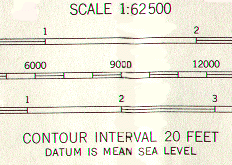|

| A snapshot of the entire map.
Rapid examination of the whole map shows that it is not uniform. It has three distinct land regions plus one major, interesting water feature: - Region 1: A series of parallel, straight belts of closely spaced contour lines that run across the entire map from the center of the west margin to the northern half of the east margin.
- Region 2: To the NW of region 1, contours are spaced further apart and are not, in general, straight or parallel to each other.
- Region 3: To the SE of region 1, contours are spaced further apart and are not, in general, straight or parallel to each other.
- Water feature. A major, broad stream (the Susquehanna River) runs in a crooked fashion from the northern margin of the map to the southern margin of the map, cutting right through regions 1, 2 and 3.
|


















